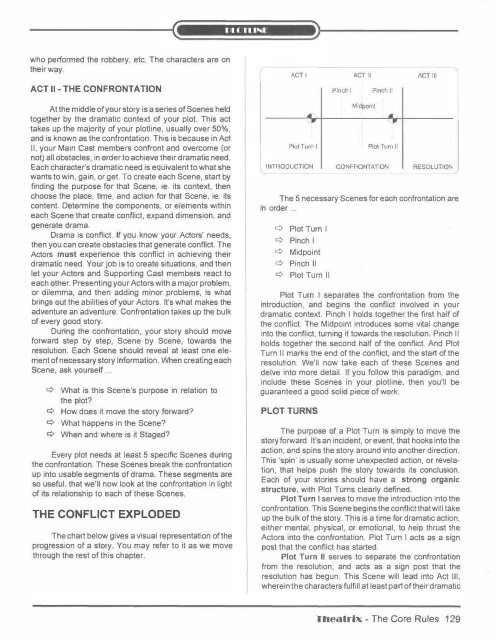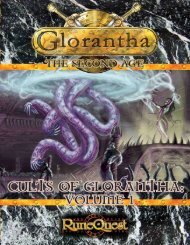Untitled - Index of - Free
Untitled - Index of - Free
Untitled - Index of - Free
Create successful ePaper yourself
Turn your PDF publications into a flip-book with our unique Google optimized e-Paper software.
who performed the robbery, etc. The characters are on<br />
their way.<br />
ACT II -THE CONFRONTATION<br />
At the middle <strong>of</strong> your story is a series <strong>of</strong> Scenes held<br />
together by the dramatic context <strong>of</strong> your plot. This act<br />
takes up the majority <strong>of</strong> your plotline, usually over 50%,<br />
and is known as the confrontation. This is because in Act<br />
II, your Main Cast members confront and overcome (or<br />
not) all obstacles, in order to achieve their dramatic need.<br />
Each character's dramatic need is equivalent to what she<br />
wants to win, gain, or get. To create each Scene, start by<br />
finding the purpose for that Scene, ie. its context, then<br />
choose the place, time, and action for that Scene, ie. its<br />
content. Determine the components, or elements within<br />
each Scene that create conflict, expand dimension, and<br />
generate drama.<br />
Drama is conflict. If you know your Actors' needs,<br />
then you can create obstacles that generate conflict. The<br />
Actors must experience this conflict in achieving their<br />
dramatic need. Your job is to create situations, and then<br />
let your Actors and Supporting Cast members react to<br />
each other. Presenting your Actors with a major problem,<br />
or dilemma, and then adding minor problems, is what<br />
brings out the abilities <strong>of</strong> your Actors. It's what makes the<br />
adventure an adventure. Confrontation takes up the bulk<br />
<strong>of</strong> every good story.<br />
During the confrontation, your story should move<br />
forward step by step, Scene by Scene, towards the<br />
resolution. Each Scene should reveal at least one ele<br />
ment <strong>of</strong> necessary story Information. When creating each<br />
Scene, ask yourself ...<br />
¢ What is this Scene's purpose in relation to<br />
the plot?<br />
¢ How does it move the story forward?<br />
¢ What happens in the Scene?<br />
¢ When and where is it Staged?<br />
Every plot needs at least 5 specific Scenes during<br />
the confrontation. These Scenes break the confrontation<br />
up into usable segments <strong>of</strong> drama. These segments are<br />
so useful, that we'll now look at the confrontation in light<br />
<strong>of</strong> its relationship to each <strong>of</strong> these Scenes.<br />
THE CONFLICT EXPLODED<br />
The chart below gives a visual representation <strong>of</strong> the<br />
progression <strong>of</strong> a story. You may refer to it as we move<br />
through the rest <strong>of</strong> this chapter.<br />
ACT I<br />
Plot Turn I<br />
INTRODUCTION<br />
in order ...<br />
ACT II<br />
Pinch I Pinch II<br />
Midpoint<br />
Plot Turn II<br />
CONFRONTATION<br />
ACT Ill<br />
RESOLUTION<br />
The 5 necessary Scenes for each confrontation are<br />
¢ Plot Turn I<br />
¢ Pinch I<br />
q Midpoint<br />
q Pinch II<br />
¢ Plot Turn II<br />
Plot Turn I separates the confrontation from the<br />
introduction, and begins the conflict involved in your<br />
dramatic context. Pinch I holds together the first half <strong>of</strong><br />
the conflict. The Midpoint introduces some vital change<br />
into the conflict, turning it towards the resolution. Pinch II<br />
holds together the second half <strong>of</strong> the conflict. And Plot<br />
Turn II marks the end <strong>of</strong> the conflict, and the start <strong>of</strong> the<br />
resolution. We'll now take each <strong>of</strong> these Scenes and<br />
delve into more detail. If you follow this paradigm, and<br />
include these Scenes in your plotline, then you'll be<br />
guaranteed a good solid piece <strong>of</strong> work.<br />
PLOT TURNS<br />
The purpose <strong>of</strong> a Plot Turn is simply to move the<br />
story forward. It's an incident, or event, that hooks into the<br />
action, and spins the story around into another direction.<br />
This 'spin' is usually some unexpected action, or revela<br />
tion, that helps push the story towards its conclusion.<br />
Each <strong>of</strong> your stories should have a strong organic<br />
structure, with Plot Turns clearly defined.<br />
Plot Turn I serves to move the introduction into the<br />
confrontation. This Scene begins the conflict that will take<br />
up the bulk <strong>of</strong> the story. This is a time for dramatic action,<br />
either mental, physical, or emotional, to help thrust the<br />
Actors into the confrontation. Plot Turn I acts as a sign<br />
post that the conflict has started.<br />
Plot Turn II serves to separate the confrontation<br />
from the resolution, and acts as a sign post that the<br />
resolution has begun. This Scene will lead into Act Ill,<br />
wherein the characters fulfill at least part <strong>of</strong> their dramatic<br />
Theatr-lx - The Core Rules 129<br />
l



